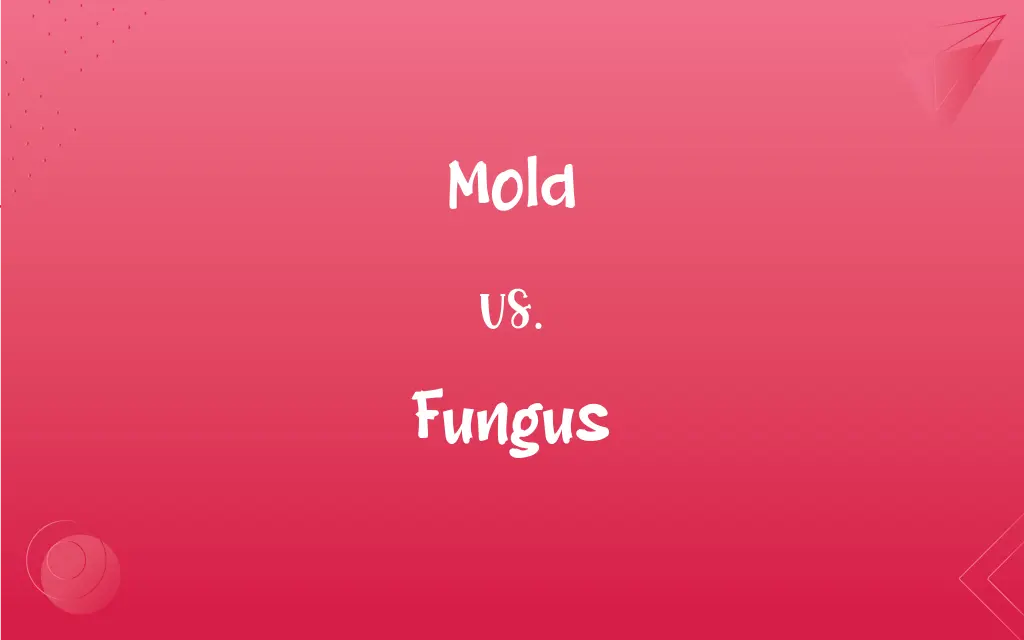Mold vs. Fungus: What's the Difference?
Edited by Aimie Carlson || By Harlon Moss || Updated on October 10, 2023
Mold is a type of fungus characterized by a fuzzy appearance and often found in damp places. Whereas, fungus is a kingdom of organisms that includes molds, yeasts, and mushrooms.

Key Differences
Mold typically thrives in damp or humid conditions and is often associated with decaying matter, contributing to the breaking down of organic materials. On the other hand, the fungus is a broader term, encompassing a wide variety of organisms, including molds, mushrooms, and yeasts, which have a range of habitats and functions in ecosystems.
Observing mold, it appears in various colors like black, green, or blue and presents itself in a fuzzy or slimy manner, visibly proliferating in its habitat. Fungus though, can vary widely in appearance and texture, from the gilled structures of mushrooms to the single-celled organism of yeast, demonstrating vast morphological differences.
While mold usually signals spoilage or decay, like on old bread or fruit, its existence also implies a risk to human health through the potential production of mycotoxins. On the opposite side, not all fungi are harmful or undesirable; for example, yeasts are utilized beneficially in processes like brewing and baking.
In a biological context, mold signifies a certain group within the fungi kingdom, implying that all molds are fungi but not all fungi are molds. In contrast, fungus represents a whole kingdom of organisms that is much more diverse, offering a vast array of roles, from decomposition to forming symbiotic relationships with plants and animals.
Moreover, mold plays a vital role in nature by breaking down dead organisms and recycling nutrients back into the ecosystem. Meanwhile, fungus, in its various forms, not only aids decomposition (like molds) but also contributes to vital processes like nutrient cycling, mutualistic symbiotic relationships (such as mycorrhizal fungi), and even pathogenicity in plants and animals.
ADVERTISEMENT
Comparison Chart
Part of Speech
Noun
Noun
Plural Form
Molds
Fungi or Funguses
Example Sentence
Mold grows on bread
Fungus can be beneficial
Associated Words
Moldy
Fungal
Usage in a Phrase
Mold contamination
Fungus among us
ADVERTISEMENT
Mold and Fungus Definitions
Mold
A frame or template for shaping.
The artist used a mold to create the statue.
Fungus
A spore-producing organism feeding on organic matter.
A mushroom is a type of fungus.
Mold
A fungal growth, especially in damp conditions.
Mold can develop on bread left in a humid environment.
Fungus
A condition caused by fungal infection.
Athlete's foot is a common fungus.
Mold
A distinctive and typical style, form, or character.
She was cast in the same mold as her predecessor.
Fungus
A dull or colorless person.
The party was fun until that fungus showed up.
Mold
To guide or determine the growth or development.
His personality was molded by his parents' values.
Fungus
An undesirable quality or element.
His anger was the fungus ruining the relationship.
Mold
To form (an object) out of malleable material.
She molded the clay into a beautiful sculpture.
Fungus
Any of numerous spore-producing eukaryotic organisms of the kingdom Fungi, which lack chlorophyll and vascular tissue and range in form from a single cell to a mass of branched filamentous hyphae that often produce specialized fruiting bodies. The kingdom includes the yeasts, smuts, rusts, mushrooms, and many molds, excluding the slime molds and the water molds.
Mold
A hollow form or matrix for shaping a fluid or plastic substance.
Fungus
(mycology) Any member of the kingdom Fungi; a eukaryotic organism typically having chitin cell walls but no chlorophyll or plastids. Fungi may be unicellular or multicellular.
Mold
A frame or model around or on which something is formed or shaped.
Fungus
A spongy, abnormal excrescence, such as excessive granulation tissue formed in a wound.
Fungus
Any one of the Fungi, a large and very complex group of thallophytes of low organization, - the molds, mildews, rusts, smuts, mushrooms, toadstools, puff balls, and the allies of each. See fungi.
Fungus
A spongy, morbid growth or granulation in animal bodies, as the proud flesh of wounds.
Fungus
A parasitic plant lacking chlorophyll and leaves and true stems and roots and reproducing by spores
Fungus
A member of the Fungi kingdom, distinct from plants and animals.
A scientist studied the fungus to discover new medicinal properties.
FAQs
Can fungi be beneficial?
Absolutely, some fungi, like yeast, are crucial in food production, and others, like penicillium, are used in medicine.
Is mold harmful to humans?
Yes, some molds produce mycotoxins and can lead to allergic reactions or respiratory issues in humans.
Can mold grow on various materials?
Yes, mold can grow on numerous materials, such as food, walls, and fabric, especially in damp conditions.
Is yeast a fungus?
Yes, yeast belongs to the fungi kingdom and is used in baking and brewing.
Are there edible fungi?
Yes, several fungi, like certain mushrooms and truffles, are edible and used in culinary applications.
What is mold?
Mold is a type of fungus that grows in multicellular filaments and thrives in damp conditions.
Can mold be useful?
Yes, certain molds are beneficial, such as Penicillium, used in making penicillin and certain cheeses.
What role does fungus play in ecosystems?
Fungi play a crucial role in ecosystems, contributing to decomposition, nutrient cycling, and forming symbiotic relationships.
Do all fungi form mushrooms?
No, not all fungi form mushrooms; some exist as single cells like yeasts or form molds.
Is mold always visible?
No, mold is not always visible and can grow in hidden areas, like behind walls.
Can fungi be used in biotechnology?
Yes, fungi are used in biotechnology, for example in fermenting processes and the production of enzymes and drugs.
Can mold appear in various colors?
Yes, mold can appear in a range of colors, including black, green, and white.
How does fungus reproduce?
Fungi typically reproduce through both sexual and asexual means, often involving the production of spores.
Can mold cause food spoilage?
Yes, mold can cause food spoilage and is often visible on the surface of affected items.
Can mold exist indoors?
Yes, mold can exist indoors, especially in damp, humid, and poorly ventilated areas.
How can mold be removed?
Mold can be removed using specific cleaning solutions and ensuring the affected area is dried thoroughly.
Can mold growth be prevented?
Mold growth can often be prevented by controlling humidity and ensuring proper ventilation.
What is fungus?
Fungus is a kingdom of spore-producing organisms which includes molds, yeasts, and mushrooms.
Are mushrooms a type of fungus?
Yes, mushrooms are a type of fungus, belonging to the Agaricomycetes class.
Can fungus grow on animals?
Yes, certain fungi can grow on animals, sometimes causing infections, like ringworm.
About Author
Written by
Harlon MossHarlon is a seasoned quality moderator and accomplished content writer for Difference Wiki. An alumnus of the prestigious University of California, he earned his degree in Computer Science. Leveraging his academic background, Harlon brings a meticulous and informed perspective to his work, ensuring content accuracy and excellence.
Edited by
Aimie CarlsonAimie Carlson, holding a master's degree in English literature, is a fervent English language enthusiast. She lends her writing talents to Difference Wiki, a prominent website that specializes in comparisons, offering readers insightful analyses that both captivate and inform.































































